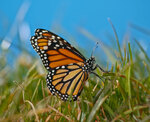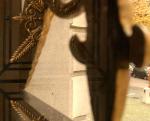rethink sustainability
Seabirds: the secret fertilisers who give so much for nothing
Fertiliser was not a common concept 200 years ago. It was Prussian geographer Alexander von Humboldt who came across something that the Incas had been using on their land for centuries - the excrement of birds. These tiny black pellets known as ‘guano’ spread across the world, resulting in fortunes for some as the full, natural potential of how they could accelerate agriculture was realised. And this does not cost anything as the birds that make it every day do not charge, instead, they add immeasurably to the health of the planet.
So how did this natural resource, which is high in nitrogen and phosphorous, come from the coasts of Peru to the shelves of our local garden centre, creating a USD 1.1 billion industry in the process?
What is it?
Described as a shot of energy for plants, guano is made up of nitrogen, phosphate and potassium - all vital for plant growth. It comes from the droppings of seabirds and is collected mainly from islands off the coasts of Peru, lower California and Africa - all places that are heavily populated by cormorants, pelicans and gannets.
Mining guano largely relies on manual labour as heavy machinery isn’t used to avoid frightening the birds1. After being collected, it is brought to sieves where the impurities are filtered out.
Early beginnings
Well before von Humboldt arrived in Peru, the Incas2 had been using the excrement of birds for years and by the 17th century, guano was in almost endless abundance. But it was the arrival of the geographer that brought it to worldwide attention. Walking along the docks in Lima one day, the ammonia-rich guano made him sneeze.
Realising the potential for its use as fertiliser, von Humboldt brought it back to Europe where chemists soon also recognised its power. At the time, farmers were concerned about their ability to feed a growing population with the land they had. When they used the guano and saw it worked extremely well, they feared the land would be unable to sustain such growth.
In the United States meanwhile, farmers also found production spiralling up, resulting in rapidly increasing demand from across the country. The Peruvian government, realising the potential, pushed up prices. As demand became so great, unscrupulous dealers started mixing the guano with earths, stones and sawdust prompting buyers to always have a chemist on hand to ensure the shipments were pure.
With the boom came a bust. By the 20th century, new chemical fertilisers could take nitrogen from the air and were easier to obtain and were less smelly. At the end of the Second World War, plants built by the US government to produce nitrogen for bombs were repurposed to produce ammonia for fertiliser. Soon fertilisers had taken over, and guano started to fade, bringing down the Peruvian economy with it.

And today
Today, seabird guano is still prized3 for the natural properties it brings, especially to fruiting and flowering plants. And while it is not the world dominating industry that it once was, it is estimated to be worth some USD 1.1 billion.
Researchers published a study in Trends in Ecology and Evolution putting the figure on the value of guano by estimating the cost of the ecological functions that it carries out. While the primary value of the guano produced every year was less than USD 500 million, the secondary economic benefits are some USD 650 million when the nutrients provided from seabirds to coral reef stocks are taken into account.
That USD 1.1 billion figure still underestimates its real value. The use of guano removes the need for chemical fertilisers, which are often derived from petroleum by-products, and the process of producing it is in itself carbon intensive. It is a testament to the natural beauty of guano that it’s not only free but it replaces something that is causing environmental damage. Overuse of chemical fertilisers is a major concern - just 17% of the nitrogen used in fertilisers ends up in our food, the rest goes into soil and water. Fertiliser pollution in lakes and the ocean causes massive blooms of algae, which use up the oxygen dissolved in the water, suffocating other species, sometimes in dead zones which stretch for kilometres.
"Guano production is an ecosystem service made by seabirds at no cost to us...I can go to an island, collect the guano, and sell it at market price as fertiliser," said Marcus V. Cianciaruso, ecology professor at the Federal University of Goiás in Brazil.
In the world’s transition to net zero by 2050, natural resources such as guano play a central part. As well as offering a rich source for fertilisation, the by-product takes away the need for materials that will do the planet more harm.
The dangers within
Like many of nature’s creatures, seabirds such as gulls and pelicans are under threat and do not always get the attention they need. By putting a figure - USD 1.1 billion - on the value that guano brings to the world, ecologists hope that public opinion will be able to focus on how important they are.
In the Antarctic, penguins provide half of the nitrogen and phosphorus deposits. As climate change eats away at our ice caps, scientists are now concerned that these birds will soon become extinct.
Maintaining the legacy
The transition to a more nature-positive economy will depend on rethinking the potential of resources like guano. It does not just hold a single purpose – it holds many. It fertilises plants. It helps to maintain coral reef stocks. It is one of the many cogs that make up the Natural Capital wheel which underpins our planet’s geology, soil, water and air.
And it is vital that we protect the birds that produce guano. Climate change and sea pollution as well as overfishing has meant that many seabirds are under threat today. Scientists have put the health of bird populations as one indicator of the health of the wider environment - meaning that when their number deteriorates, the planet overall is suffering.
And that also means that our economy is suffering. At present, some 92 billion tonnes of natural resources are taken from the Earth every year but we produce approximately 70 billion tonnes of waste annually, over half of which is in the form of emissions and untraced forms of waste and pollution.
Instead we must endeavour to transition to an economy that is Circular, Lean, Inclusive and Clean: the CLIC™ economy. This is one where natural resources are not exploited but protected and harnessed in a regenerative manner. And one feature of this is to protect the birds that produce the fertiliser that helps the land that feeds us.
1 https://en.wikipedia.org/wiki/Guano
2 https://www.atlasobscura.com/articles/when-the-western-world-ran-on-guano
3 https://www.planetnatural.com/product-category/organic-gardening/organic-fertilizers/seabird-bat-guano/
Important information
This document is issued by Bank Lombard Odier & Co Ltd or an entity of the Group (hereinafter “Lombard Odier”). It is not intended for distribution, publication, or use in any jurisdiction where such distribution, publication, or use would be unlawful, nor is it aimed at any person or entity to whom it would be unlawful to address such a document. This document was not prepared by the Financial Research Department of Lombard Odier.
Read more.








share.